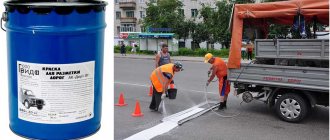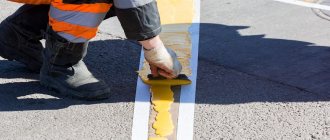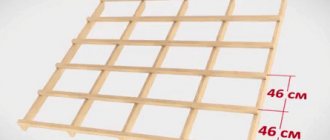Road pavement helps provide highways with the highest possible performance characteristics due to the specific functionality of each technological layer. If the pavement structure is constructed with violations or errors, the physical and mechanical characteristics of the road will be lower than designed, which will shorten the service life of the road surface.
“Road pavement is a structure made of several technological layers, used in the construction of highways, pedestrian zones and some other objects. The main purpose of multi-layer road pavement is to redistribute and absorb the load on the pavement, as well as improve the characteristics of the road surface.”
High-category roads have a more complex pavement design than low-category roads, which is due to the different purposes of the objects. However, the cost of laying asphalt and installing the base is recouped by achieving high strength and durability of the pavement, as well as reducing the need for repairs.
Why is road clothing made multi-layered?
Optimally selected materials of structural layers, as well as their quantity and thickness, make it possible to most effectively absorb external loads on the road surface, as well as ensure high strength and stability of the entire structure.
Thanks to the correct design of the road, the load created by traffic flow is redistributed over a larger area, and also attenuates as it deepens. Accordingly, the pavement must have characteristics suitable for the design load on the road surface.
Example
. For a federal highway, along which not only passenger but also freight vehicles constantly move, the thickness of some technological layers will be greater, and the materials used will be of better quality. In addition, it is necessary to take into account the increase in traffic load in the future. It is also possible to use additional materials and technologies to strengthen the structure.
How is the strength of layers distributed?
| Pavement area | Short description |
| Upper structural layers | They have higher strength and hardness. Designed to resist mechanical wear, deformation and stretching. |
| Lower structural layers | They have lower strength and hardness. Designed to resist compression and shear. |
In other words, the further from the surface, the lower the strength and hardness of the materials, since different depths are subject to loads of different types.
. It is thanks to this laying format that road pavement has high and balanced physical and mechanical characteristics.
What structural layers does the pavement have?
Road pavement for almost any object consists of the following groups of layers:
- Surface wear layer;
- Upper layer;
- Base;
- Subgrade.
In more detail, a typical roadway design looks like this:
- Several layers of different asphalt concrete;
- Crushed stone layer of crushed stone of different fractions;
- Geogrid or geogrid;
- Sand layer;
- Geotextiles;
- Subgrade.
Also, during the construction of some types of roads, additional geogrid can be laid between layers of asphalt concrete to improve the performance characteristics of the asphalt concrete pavement.
In addition, bitumen emulsions are poured between layers of asphalt and crushed stone, as well as between adjacent layers of asphalt concrete, which increases adhesion. Bitumen cannot be called a separate structural layer, but no road pavement can do without it.
Rice. 8. Structural layers of road pavement: 1 - covering, 2 - base, 3 - additional base layer, 4 - subgrade soil
Rice. 9. Transverse profiles of road pavements: a - trough, b - half-trough, c - sickle-shaped
The coating is the top, most durable layer of road pavement. It absorbs loads directly from passing vehicles and provides the necessary operational qualities of the road - strength and evenness of the surface, high coefficient of tire adhesion and wear resistance. The coating is often divided into a wear layer and a base layer. The wear layer is periodically renewed as abrasion occurs.
The transverse profiles of the road pavement (Fig. 9) can be trough, semi-trough and crescent-shaped. The most common is trough.
Road surfaces are divided into the following four main types: - improved capital - cement concrete, asphalt concrete, pavements made of paving stones and mosaics on a stone or concrete base; - improved lightweight - from crushed stone and gravel materials treated with bitumen or tar; – from cold asphalt concrete; – from soil treated in a plant with viscous bitumen; – transitional—crushed stone; – gravel; slag; – ground, treated with bitumen or tar; – cobblestone streets; -lower ones are ground, reinforced with various local materials.
Typical road pavement designs are shown in Fig. 10.
Road pavements with cement concrete coating are most often installed on roads of categories I, II and III. They include the following structural layers (Fig. 10, a): monolithic cement-concrete covering; a leveling layer of untreated sand or sand improved with bitumen (when profiling bases from reinforced soils, a leveling layer is not made); base made of crushed stone, gravel or soil treated with cement or bitumen; frost-protective and draining additional base layer.
Rice. 10. Road pavement structures with different types of coatings: a - cement concrete pavement, b - asphalt concrete pavement on a crushed stone base, c - asphalt concrete pavement on a concrete base, d - asphalt concrete pavement on soil reinforced with cement, e - crushed stone pavement with a treated top layer by impregnation method, e - gravel surface treated with bitumen by mixing on the road, g - gravel surface on the road of the lowest category; 1 - cement concrete, 2 - leveling layer of sand treated with bitumen, 3 - layer of crushed stone, gravel or soil treated with binder material, 4 - frost-protective layer of sand, 5 - fine-grained asphalt concrete, b - layer of crushed stone, 7 - coarse-grained asphalt concrete, 8 - soil reinforced with cement, 9 - crushed stone treated with impregnation, 10 - gravel treated with bitumen, 11 - gravel
Cement concrete road surfaces can be reinforced or unreinforced, single-layer (when laying the concrete mixture in one layer) or two-layer (when laying the concrete mixture in two layers). Two-layer concrete coatings allow the use of less durable stone materials in the concrete for the lower layer. The thickness of the top layer of concrete in two-layer coatings is taken to be at least 6 cm.
The thickness of concrete pavements laid on crushed stone, gravel or reinforced soil base for category I roads must be 22 cm, category II 20 cm, category III 18 cm. Sand bases can only be used on category III roads and in certain areas with low traffic intensity of roads of category II. The thickness of the concrete coatings in this case should be 22 and 20 cm, respectively.
To reduce stresses in concrete and protect the cement concrete coating from the formation of cracks that occur when the ambient temperature changes, longitudinal joints and transverse expansion and compression joints are installed (Fig. 11).
The longitudinal seam is cut when the coating width is more than 4.5 m, which eliminates the formation of longitudinal cracks in the coating.
Transverse expansion joints provide longitudinal stability of the coating when heated in summer. They are arranged depending on the ambient temperature when laying the mixture approximately 24-60 m over the entire thickness of the slab. When using trackless coating construction technology, expansion joints are installed at the end of each work shift and when there are interruptions in the supply of the mixture for more than 20-30 minutes.
Rice. 11. Layout of seams in a cement concrete coating: 1 - expansion seam, 2 - compression seam, 3 - longitudinal seam, 4 - pins
Transverse compression joints 2 provide the ability to contract the slabs as the temperature drops. The width of the seam is 0.6-1 cm. They are cut to a depth of at least 0.25 times the thickness of the coating and placed at a distance of 5-8 m from one another. To ensure that the plates work together and maintain their relative position, steel rods are inserted into the seams - pins 4, which prevent the plates from moving. The pins are inserted perpendicular to the transverse seam to a depth equal to half the thickness of the coating. To freely move some slabs relative to others in the horizontal direction when there is a temperature difference, half the pin is coated with bitumen to prevent this part of the pin from sticking to the concrete of the adjacent slab. When installing cement concrete pavements on reinforced bases, it is permissible not to place the pins in the transverse joints. The seams are filled with waterproof material.
Cement concrete pavements are constructed using a set of machines for the construction of cement concrete road pavements.
Asphalt concrete pavements are made on roads of categories I-III from asphalt concrete mixtures laid on a strong, rigid base and carefully compacted. Asphalt concrete coatings can be one- and two-layer on crushed stone, concrete and reinforced soil (see Fig. 10, d) bases. Work on the installation of asphalt concrete pavements is fully mechanized.
Improved black crushed stone and gravel coatings (see Fig. 10, e, f, g) are arranged using impregnation or mixing in special installations. Impregnation is the introduction of heated viscous bitumen or emulsions into the coating by pouring 0.8-1 liters per 1 m2 of an under-rolled layer of crushed stone using asphalt distributors. After this, the surface of the coating is covered with fine crushed stone and compacted with rollers. When using a mobile mixing plant, gravel or crushed stone is collected into a longitudinal roller by a motor grader and fed into the plant by an elevator bucket loader. The mineral material mixed in the installation with bitumen is distributed over the base, leveled with a motor grader and compacted with rollers.
The bases of road pavements are made of crushed stone, gravel, slag or soil reinforced with binding materials. In some cases, crushed stone and gravel bases are impregnated with bitumen or tar.
—-
To ensure year-round passability, regardless of weather conditions, road pavement is installed on the roadway (Fig. 5).
Road pavements on highways may consist of one or several structural layers: coating (the upper load-bearing layer that characterizes the operational and transport qualities of the roadway); bases (the main load-bearing layer that ensures the stability of clothing structures); additional layer (underlying, load-bearing, leveling layer).
Rice. 5. Road pavement: a - with crushed stone or gravel surface; b - with asphalt concrete pavement; c - with demite concrete coating; 1 - top layer; 2—bottom layer; 3 - underlying layer; 4 - base
Road surfaces can be divided into the following main types.
The lower ones are from soils improved with granulometric additives (sand, gravel, etc.); from soils with a selected granulometric composition.
Transitional - from natural gravel or from artificially selected gravel mixtures, from crushed stone of a certain shape and size; soil, reinforced with binding materials.
Improved lightweight ones - black crushed stone and black gravel on bases: crushed stone, gravel, slag and stone, as well as soil-gravel and soil, treated with organic binding materials.
Improved capital - cement concrete and asphalt concrete, black crushed stone, mosaic and cobblestone pavements on foundations: concrete, crushed stone, slag, soil-crushed stone and soil reinforced with binding materials.
The type of coverage is selected based on the category and traffic intensity.
Top layers of asphalt concrete
Road pavement includes several layers of asphalt concrete of varying densities. First of all, a more porous asphalt mixture is laid, and then a less porous and more durable one, designed to resist wear, as well as increase the surface roughness to ensure traction of car wheels with the road.
Also, the dense top layer of asphalt prevents moisture from entering the inner layers of the roadway, which increases the service life of the structure. If water gets into the inner layers of the coating, when it freezes, expansion will occur, which can destroy the coating from the inside. This is especially true for our country, since throughout the year there are repeated temperature changes from plus to minus, and vice versa.
The main types of asphalt concrete by composition:
- Sandy;
- Gravel;
- Crushed stone-mastic.
Sandy asphalt
has the lowest performance characteristics from this list, therefore it is suitable for installing only those types of coating that will not be subject to serious external influences. These could be pedestrian areas or some private areas.
Gravel asphalt
has higher physical and mechanical characteristics, and can be used to pave high-category roads. However, at present, this type of asphalt concrete has been almost completely replaced by crushed stone-mastic mixtures.
Crushed stone mastic asphalt (SCMA)
is the leader of this list in terms of its performance characteristics. Can be used, among other things, for category I roads with increased traffic load. Hard rocks in the composition of SMA form a strong coating frame, and the addition of special cellulose fibers prevents the spreading of the bitumen binder.
note
. The cost of laying asphalt will vary depending on the material, as more durable asphalt concrete costs more. However, due to its high physical and mechanical characteristics and long service life, the use of high-quality asphalt is more than justified.
The main types of asphalt concrete according to laying technology:
- Hot;
- Cold;
- Cast.
| Material | Description |
| Hot asphalt | Hot asphalt has high performance characteristics, so road pavement using this asphalt concrete can be used for the construction of roads of any category. When laying, the mixture must be heated to 110-130°C, and the air temperature must be at least +5°C. |
| Cold asphalt | Cold asphalt has lower physical and mechanical characteristics and is therefore not suitable for pavement on busy roads. However, the advantage of cold asphalt is different - strength gains occur due to the evaporation of hydrocarbon compounds. Thanks to this, this material does not need to be heated before installation, and work can be carried out even in cold seasons. Most often, cold mixtures are used for pothole repair, which is especially important when the coating needs to be brought back to normal as soon as possible. |
| Cast asphalt | Cast asphalt can be classified as a hot mix, since it is heated to 190-250°C before laying. Like hot cast asphalt concrete, it has high performance characteristics and can be laid at air temperatures from +5°C. The main feature of cast mixtures is that there is no need for compaction after installation. This material has a liquid consistency, and the increase in strength during the cooling process ensures a residual porosity within 2%. Can be used for roads of any category. |
Classification of coatings
Various conditions have been developed for the classification of road clothing, which depend on the purpose for which and on what roads it is laid. For example, in fields or on unstable soils there is no point in laying asphalt, since it will very quickly fail and waste will go into the air. Therefore, dirt roads with additional embankment are left there. More and more people are starting to use materials with organic components, which are cheaper but not inferior in sustainability. It is more common for us to see asphalt roads, but the asphalt itself can be of several types. Concrete surfaces continue to be popular. Each of them is worth considering in more detail.
Covering for unpaved roads
Due to certain circumstances, dirt roads continue to be very popular. Some remote settlements can only be reached via them. If you leave their covering unreinforced, then it turns into mush after heavy rains or a spring thaw. That is why their coating must be formed according to a certain profile. To do this, they use soil that is removed after digging pits or canals. Those who have used these types of surfaces during the dry season know that traveling in a convoy is problematic. The disadvantage is the rise of clouds of dust. Another disadvantage is the limited speed of movement after the formation of a deep rut.
To eliminate the shortcomings, various components are added. These may include gravel and sand. If they are sufficiently maintained, the road surface remains suitable for movement even in heavy rains. The best dirt roads are those built on clay layers. When laying crushed stone, coarse sand and other fastening components, good compaction and mixing is carried out. In this way, relative solidity and better load-bearing capacity are achieved.
Dirt roads have certain restrictions on passability. The norm is considered to be 100 cars that cross the roadway per day. If such a road surface is exposed to more intense impact, then it loses its properties and the laying of asphalt or other components is required. Since there are no restraining supports, expansion of the web can occur due to a decrease in its thickness. Therefore, constant filling and leveling of the surface is carried out using graders or tractors.
Note! To increase the passability of dirt roads, a bitumen base or cement is added to the fill surface. In this case, up to 500 cars per day are allowed. But the problem still remains for trucks with large axle loads.
Coating with organic components
Capital roads require significant costs, which are expressed in man-hours, as well as in engine hours of the equipment used. In some areas where the flow of vehicles does not exceed 3 thousand cars per day, lightweight coatings are laid. Their structure resembles ground coverings, which are additionally reinforced. An impregnating material is laid on the top layer of the flooring, which holds the components together, preventing them from scattering and spreading. These types of roads provide the possibility of moving trucks and other cargo vehicles. Moreover, such a flow is not limited to any time of the year.
The basis of such a coating is crushed stone or coarse gravel. A layer of coating from a smaller fraction is poured on top of it, and the final layer is pebbles or small crushed stone. Bitumen or other organic binder is poured onto the prepared base. It ensures surface evenness and uniformity. At the same time, the road surface has some roughness, which is good for better traction and shorter braking distances. This type of road clothing has good water-repellent properties. The oil component prevents water molecules from fixing and penetrating into the pores. One of the disadvantages of this coating is its mediocre stability at high temperatures. In hot weather, bitumen loses its strength and becomes more viscous. In such conditions, roads may be closed to heavy vehicles.
Note! Depending on the needs of a particular area, surface impregnation can be applied in one or two layers to the road surface.
Types of asphalt
Asphalt is an improved version of the previous road surface. The composition of the road surface also includes a bitumen base or tar base complete with various concrete and other additives. This type of road surface is the most common and is used on almost all major highways and expressways. The road easily handles traffic intensity of 3 thousand or more thousand cars per day. At the same time, the movement of equipment of different weight categories is allowed. There are three types of asphalt road paving:
- cold;
- warm;
- hot.
Much depends on the additives that are included in the road surface. For heating, specialized equipment is used, which is capable of doing this independently from a power source immediately before installation. The filler, which ensures the rigidity and stability of the road surface, is used in the form of crushed stone, powdered rocks impregnated with bitumen, gravel, coarse sand and others. The larger the fraction, the harder the road surface is and the less smooth it is. This can be felt by the noise of the tires at medium and high speeds. Asphalt is never laid independently. It is a fairly elastic road surface that will not withstand the load placed on it. To ensure stability, one or several layers of coarse crushed stone lining is used. In some cases, locally available pavement material is used, such as rock that has been crushed after explosive mining. The thickness of the underlayment depends on many weather and landscape conditions.
There are few disadvantages to this type of road surface, but they still exist. All varieties of such road floorings, which contain a dark mineral component, absorb light well. This creates difficulties on sunny days, as the surface heats up to significant temperatures. The consequence is a decrease in the strength of such road flooring and a negative impact on the tires. At twilight, this is a problem, because the lights of oncoming cars are difficult to see. The solution to this issue for road flooring is to use reflective paint for markings, which allows for better orientation. In some cases, the surface is made lighter by adding components that contain various calcium oxides.
In other options, a layer of light filler is laid on hot soft asphalt. Using rollers, it is simply pressed or recessed into the top layer. After setting, the surface of the road deck becomes monolithic and better reflects light. Incomplete lightening of the surface is allowed, but alternating. This approach to the road surface not only affects the performance of the deck itself, but also reduces driver fatigue. In areas with a monotonous landscape, there is less chance that the driver will lose vigilance and fall asleep.
Concrete plates
In some countries, the use of asphalt decking is not as common. As an alternative, roads with concrete surfaces or cement concrete are used. They are not inferior in their characteristics and strength to various types of asphalt. Moreover, the maintenance of such road decks is cheaper, and the installation process is as automated as possible. During the processing of this type of road flooring, a special rough texture is created, which provides excellent grip. When this type of road decking is installed correctly, no other road can compare in terms of surface evenness. Such coatings can easily withstand a load of more than 3 thousand cars per day.
One type of technology involves monolithic laying of a concrete slab with a continuous supply of cement concrete. In others, which are more common in our area, ready-made and seasoned slabs are delivered to the site. For maximum strength of the road flooring, they can undergo vibration or steam treatment. This type of paving also requires a stabilizing underlay or base. It uses various types of crushed stone, rocks, as well as coarse sand. The use of the latter under such road flooring is allowed in lightly congested areas. The thickness of the layer will depend on the specific conditions. The width of the lining for the road flooring is made with a margin of 50 cm on each side.
For cement concrete road decks, a careful selection of components and components is carried out. High demands are placed on cement, which is the main component. Its grade must be equal to or higher than M300. The thickness of such road flooring can reach 24 cm along its entire length. In this case, the technological process implies the presence of a slope towards the roadsides. It is necessary so that liquid can flow freely from the road.
Note! Increasing the strength of the road surface along with reducing its thickness can be achieved by using reinforcing mesh.
Temperature fluctuations have their effect on the road surface. If certain actions are not taken, then such road flooring will crack and become unusable. That is why, every 80 meters or less, a transverse cut of the road flooring is made with a width of 3 cm. A special elastic material is placed in it, which will “play” when compressed and expanded. Another type of transverse joints in concrete pavements are compression joints. They are located at a distance of up to 10 m and have a depth of up to 5 cm.
Note! In addition to longitudinal seams on the road deck, there are also longitudinal ones. They can be located in the middle of the slab if the total width of the road is 7 m. They can also be parallel to the axis, but interrupted every 3.5 m. If they are present, it is mandatory to lay reinforcement that will prevent the slabs from moving out of their place.
Crushed stone layer
High quality crushed stone
under layers of asphalt concrete can increase the performance of the entire road pavement. The crushed stone layer is laid either in mixed fractions at once, or first in larger ones and then in smaller ones on top. This is necessary to ensure sufficient density of this technological layer.
The higher the characteristics of the crushed stone, the higher the performance of the entire layer will be. For example, today the so-called “black crushed stone” is often used. Road pavement using such material will be even more durable and stable.
Black crushed stone mixture
represents a balanced proportion of crushed stone and binder material. Crushed stone can be granite, gravel or limestone. Bitumen emulsions most often act as binders.
Lightweight and transitional pavements
2.25. Lightweight road pavements with improved coatings (asphalt concrete, tar concrete, black crushed stone, crushed stone treated with binders by impregnation, coarse-grained materials, sandy or sandy loam soils treated in an installation with bitumen emulsion together with cement) must be used primarily on roads III, IV, II-c and IVp categories (Fig. 2.2) and during the staged construction of road pavements at the first stage of construction of roads of II, II-c and IIIp categories. Such pavements can also be installed on intra-farm roads of industrial and agricultural enterprises, where, due to sanitary conditions, transitional type pavements cannot be allowed.
2.26. An improved coating of lightweight road pavements should, as a rule, be made with a thickness of 4-6 cm when using asphalt concrete and 6-8 cm when using other materials specified in clause 2.25. More precisely, the thickness of the coating must be determined based on strength.
2.27. Bases for lightweight pavements with improved surfaces, as a rule, must be constructed from monolithic and granular materials. At the same time, on roads of categories III, II-c and IV, it is advisable to arrange the base of the road pavement from gravel porous asphalt concrete; gravel-sand mixtures treated with emulsion, tar and other organic binders; various materials and soils and industrial by-products treated with inorganic or complex binders, crushed stone and crushed stone-gravel mixtures.
2.28. Road surfaces with transitional type coatings (crushed stone and gravel made of durable rocks, low-strength stone materials and soils reinforced with organic, inorganic or complex binders, pavements made of cobblestone and crushed stone) should be installed on roads of IV, III-c and V categories (Fig. 2.3). During the staged construction of road pavement, such structures must be provided at the first stage of construction of roads of III, IIIp, III-c and IVp categories. They can be used on internal roads of industrial enterprises and construction sites, where, due to sanitary traffic conditions, there is no need to install improved types of coatings. (SNiP “Highways. Design standards.”)
2.29. When designing pavements with a transitional type of coating, one should strive to ensure that the pavements consist of one or two layers.
For coatings constructed using the caulking method, fractionated crushed stone of natural rocks, crushed stone from mining waste and crushed stone from low-active metallurgical slag should be used (GOST standards for “Crushed stone from natural stone for construction work” and “Crushed stone from slag blast furnace and steelmaking for road construction”) .
2.30. When designing transitional type clothing as the primary design of staged construction for the construction of layers of clothing at the first stage, it is necessary to use materials that meet the requirements for materials for the construction of base layers for improved coatings. In some cases, in order to reduce initial costs, simplified structures may be appropriate, traffic on which during unfavorable periods of the year should be limited in terms of vehicle axle load and intensity.
Rice. 2.2. Designs of lightweight pavements for roads of categories III-IV with improved surfaces (examples):
1 - fine-grained asphalt concrete grades II-III; 2 - coarse asphalt concrete or fractionated crushed stone (gravel), treated with bitumen; 3 - selected crushed stone (gravel) mixture, crushed stone with a wedge; 4 - soil strengthened with inorganic binder; 5—high-density soil; 6 - sand, gravel, slag; 7 - crushed stone treated with organic binder in the installation; 8 - soil or material treated with complex binders; 9 - soil or low-strength stone material treated with an organic binder; 10 - high-density soil
Rice. 2.3. Road pavement structures of IV-V categories with transitional types of coatings (examples):
1 - surface treatment; 2 - selected gravel or sand mixtures, reinforced with Portland cement; 3 - sand, gravel, slag; 4 - high-density soil; 5 - soil strengthened with inorganic or liquid organic binder; 6 - crushed stone; 7 - gravel mixture; 8-gravel mixture of substandard materials, reinforced with small doses of cement; 9 – gravel-sand mixture; 10 - soil with added crushed stone
studfiles.net
Geogrid or geogrid
Geogrid or geogrid
– a special material made of durable synthetic threads and fibers, during the process of fastening which a mesh structure is formed. It has high strength and long service life, and can also have different flexibility. The geogrid under the crushed stone layer performs a reinforcing function, due to which all road pavement becomes more stable and durable.
Geogrid is a type of geogrid, but has a flatter shape, while geogrids are made voluminous.
In addition to increasing strength, geogrid also absorbs vertical loads from passing vehicles, turning them into horizontal ones and distributing them over a larger area. Due to this, the impact on deeper layers is significantly reduced.
Thus, a geogrid has three main properties:
- Reinforcement with increased strength;
- Load redistribution;
- Separation of structural layers.
If it were not for the geogrid, the crushed stone would simply be pressed into the sand, which is why the road pavement would quickly become unusable due to structural failure.
However, road pavement with geogrid has other advantages:
- Reducing crushed stone consumption by 40%;
- Reduction of economic and labor costs;
- Increased service life.
Geotextiles
Geotextiles
outwardly resembles ordinary fabric, but it is made of durable synthetic materials. In the construction of highways, geotextiles made from polypropylene or polyester synthetic fibers are most often used, but some other materials can also be used as starting materials.
This geo-fabric is characterized by high strength, sufficient elasticity, long service life and environmental friendliness.
Road pavement with geotextiles has higher characteristics due to the properties of this material:
- Creation of a reinforcing effect (in combination with geogrid, the strength of the structure can be increased by 2-2.5 times);
- Separation of structural layers;
- Drainage function;
- Prevents the germination of plants from the soil.
Considering that about 80% of the soil in our country is considered clayey, the use of geotextiles is simply necessary to ensure sufficient strength and moisture insulation.
Ground or subgrade
Before construction of a road begins, the soil base must be properly prepared. Due to this, all road pavement will have higher characteristics, as a result of which the service life of the road as a whole and each structural layer separately will increase.
Once a pit has been dug to the required depth, the subgrade is cleared and compacted to begin construction. Also at this stage, the construction of a drainage system is taking place, which will effectively drain water to the side and roads.
Classification of road pavements
Road pavement with a typical design was described above. However, in some cases, road pavement may have fewer structural layers, and at the same time the category of the coating is reduced. Road pavements can be classified according to their rigidity and level of performance characteristics.
Depending on the hardness, the following are distinguished:
- Rigid pavement – has cement concrete in the base or covering;
- Flexible pavement is a structure without the use of cement concrete.
In the Russian climate, the use of cement concrete as a coating is impossible, since this material is destroyed under the influence of low temperatures combined with transport load.
However, non-rigid road pavement has fairly high physical and mechanical characteristics.
, which are quite suitable for the construction of high-category roads.
Designs of flexible and rigid road pavements
Road pavement is a layered system designed to absorb and redistribute transport loads to a level that is permissible based on the strength of the subgrade soil. Road pavement is the main structural element of a road and its cost can account for up to 70% of the total construction cost.
Road pavement consists of a top layer - the road surface, a bottom layer - the road base and additional layers (Fig. 15.2).
Basic requirements for road clothing:
1) the required strength, evenness, surface roughness, dustlessness;
2) ensuring safe traffic;
3) profitability, determined by the costs of construction, repair and maintenance;
4) reliability, determined by the probability of failure-free operation.
coating - the top, most durable, usually waterproof, relatively thin layer of clothing that well resists abrasion, impact and shear loads from wheels, as well as the effects of natural factors. Since the coating is made from the most expensive materials, it is given the minimum permissible thickness. The coating provides the necessary operational qualities of the road (surface evenness, high coefficient of tire adhesion). In the design of the pavement, in addition to the main layer that provides the necessary qualities, a reserve layer (wear layer) is provided, which is not included in the design thickness and is subject to periodic restoration during the operation of the road.
base - a load-bearing, durable part of clothing, made of stone materials or soil treated with binding materials. It is designed to transmit and distribute pressure to additional layers of clothing located below or to the subgrade soil (underlying soil) and therefore must be monolithic, resistant to shear and bending. The base is not directly exposed to the impact of car wheels, and the influence of weather factors is transmitted to it in a somewhat mitigated form. Therefore, for its construction it is possible to use materials of lower strength than in the coating and in the wear layer. Local materials such as strong industrial waste and weak stone materials treated with binders should be widely used for its construction.
The base may consist of one or several layers. In the latter case, the upper layers of the base are made of more durable materials. The base, which is isolated from the effects of surface moisture during the installation of improved coatings, can become moistened as a result of the movement of moisture from bottom to top from the subgrade during the period of winter freezing.
additional base layers made of materials that are stable when moistened are laid between the base of the coating and the underlying soil of the subgrade in areas with unfavorable climatic and soil-hydrological conditions. In places where the roadbed is composed of silty, loamy and clayey soils, in which processes of winter moisture accumulation and heaving can develop, an additional layer of porous materials (sand, gravel or crushed stone) is introduced, which is called drainage, anti-heaving or frost protection. This layer is designed to drain excess water from the upper layers of the subgrade, drain the road surface, prevent significant swelling of the pavement and increase the strength of the subgrade soil;
subgrade soil (underlying soil, “working layer” of the subgrade) carefully compacted and graded upper layers of the subgrade, on which layers of road pavement are laid. All the pressure from transport loads is transferred to the underlying soil, so it is a very important element of the road pavement design. The strength of the road pavement can only be ensured on a homogeneous, well-compacted, non-heaving subgrade with ensured drainage. Increasing the resistance of the subgrade soil to external loads, draining it and maintaining a constant water regime are the most reliable ways to increase the strength of road pavement and reduce its cost.
According to their mechanical properties, road pavements are divided into rigid and non-rigid.
Rigid pavement is a road pavement that acts as a slab of finite dimensions on an elastic base with a free, hinged or other method of connecting the slabs. Rigid road pavement can be with a cement concrete coating, as well as with an asphalt concrete coating on a base made of cement concrete, divided by expansion joints. Coverings of rigid clothing can be monolithic and prefabricated, reinforced and unreinforced, prestressed and reinforced concrete. The main difference between rigid clothing is the presence of expansion joints, which are arranged to prevent the formation of chaotic cracks (see below for more details). In the Republic of Belarus, single-layer, monolithic cement concrete coatings are most widespread .
Rigid road pavements were used on sections of the Brest-Moscow highway, the entrance to the National Airport, Minsk-Vitebsk, Minsk-Grodno, etc.
Flexible pavement is a pavement that operates as a layered system of infinite dimensions with a continuous coating on an elastic base. Non-rigid pavements include road pavements coated with materials containing organic binders (asphalt concrete, tar concrete), complex organic and hydraulic binders (bitumen emulsions and cement), as well as coated with granular materials (crushed stone, gravel, slag). The difference between flexible and rigid clothing lies in the calculation methods and in the parameters of permissible deformations (deflections) under the wheel of the design vehicle. Since the ratio between the strength and elastic modulus of coating materials for flexible clothing is much higher than for rigid ones, the thickness of the coating layer for flexible clothing is significantly lower (on average, the thickness of an asphalt concrete coating is 10-15 cm, a cement concrete coating is 20-26 cm). This fact, as well as the better repairability of flexible road pavement coatings, has led to their much wider distribution (more than 90% in the Republic of Belarus).
The design of flexible road pavements consists of designating the type of pavement, the type of coating material, the service life of the road pavement, the type and material of the structural layers.
1. The coating can be made of 1,2,3 layers:
The top layer of coating is chosen depending on the service life and level of reliability.
The lower layers are usually used from porous, multi-crushed stone mixtures.
Leveling - from fine-grained or sandy mixtures.
2. Base – 1.2 layers.
The top layer is made of reinforced materials: crushed stone and gravel materials treated with bitumen, emulsion, complex binders, crushed stone impregnated with bitumen emulsion.
The bottom layer is made of selected crushed stone mixtures, ASG, crushed stone with a/b granulate, crushed stone impregnated with a cement-sand mixture.
3. The underlying layer is made of ASG or sand. If the subgrade soil meets the requirements, then the underlying layer is not applied.
The choice of layer materials is made by comparing the cost calculated according to all strength criteria d/o.
The design of rigid pavements includes the following layers:
1. Covering made of cotton or other (16-24 cm).
2. The base is made of cement-reinforced materials. (cement soil, cement gravel, lean concrete)
3. Technological layer – from ASG, ShchGS.
Sandy underlying layer (drainage and frost protection)
8. Design of a road route plan.
The position of the road axis on the ground is called the route
Designing a route plan includes: 1) identifying obstacles to the route and control points; 2) laying out route plan options; 3) selection of radii and lengths of transition curves; 4) picketing and compiling a list of rotation angles, straight lines and curves; 5) drawing up a “Route Plan” drawing.
Before laying the route, obstacles to the route and control points are identified. Obstacles include lakes, populated areas, and restricted areas. Control points can be places of intersection with railways, roads, and rivers.
Highways of categories I-III always intersect with railways at different levels, and roads of category IV - in some cases at the same level. In this case, the acute angle of intersecting roads must be at least 60°.
Motor roads of category 1a intersect at different levels with roads of IV categories, roads of 1b, II categories - with roads of I, II, III categories, roads of III category - with roads of III with a traffic intensity at the node of more than 8,000 vehicles per day. The intersection of roads at the same level is carried out at a right or close to a right angle.
It is recommended to design route plan options using the elastic line method using a flexible ruler, taking into account control points and obstacles
The resulting curved outline of the route plan represents the approximate position of the route (preliminary version). To ensure the possibility of placing this route on the ground, the curve is replaced by a broken straight line (Fig. 1).
After this, the rotation angles of the route (α1, α2, α3) are measured in places where the direction of the straight lines changes, the distance between the vertices of the corners (P2, P3), the distance from the beginning (point A) and the end (point B) of the route section to the nearest control points, as well as bisectors of roundings B1, B2, B3.
Fig.1. Scheme for replacing a curved route plan with a broken outline
Curves are entered into the corners of rotation in such a way that the new position of the route approximately corresponds to the position of the preliminary version of the route; the standards of the route plan are maintained (radii and lengths of transition curves and straight inserts), and there is no overlap of adjacent curves. The radius of the curves is assigned, as a rule, no less than the recommended one. If it is impossible to fit it, then it is advisable to change the position of the vertex of the angle in order to remove the restriction that forced the radius to be reduced. Approximate radii of curvatures are determined by the value of the bisector Bi and the angle of rotation αi
,(1)
If at least one of the radii obtained from (1) is less than the minimum, then the route plan should be changed to reduce αi, increase Bi, and re-calculate RBi using (1). Calculate the approximate tangents of circular curves, taking the shift p = 0,
Take the offset of the beginning of the rounding equal to ti = 0.5 Li.
Check that the lengths of straight lines P1, P2, P3, P4 (see Fig. 1) are sufficient to accommodate common tangents. Thus, the extreme straight lines P1, P4 must be no less than the total tangent of the extreme roundings, and the intermediate lines P2, P3 - the sum of the common tangents of adjacent roundings. If, for example, P3 < , then it is necessary to reduce the radius of the second or third rounding so that it is no less minimum, determine new values of the common tangents and check the condition
P3 ≥ . Picketing includes drawing pickets and plus points on the route using a meter and establishing the picket position of the vertices of the turning angles. Picket position (Fig. 1): first vertex - ВУ1 = НХ + П1; second vertex - ВУ2 = ВУ1 + П2 - Д1 end of the stroke - КХ =∑Пi - ∑Дi In the formulas, the lengths of sections of a broken path are measured on the map, and the length D is calculated by the formula. At each rounding with known values of a, R, L, calculate other rounding elements with an accuracy of 0.01 m, picket positions of the main rounding points. The lengths of the remaining straight sections of the route and their bearings are determined along the route. Rumbus (magnetic or true) is an acute angle between the nearest end of the meridian (magnetic or true) and the direction of the straight line. Directional angle is the angle between the vertical line of the 1-kilometer map grid and the direction of the straight line (Fig. 2). So, for the straight line ВУ1-ВУ2 the directional angle is equal to ДУ2 (Fig. 2).
Rice. 2. Scheme for calculating directional angle and azimuth
1 – vertical line of the kilometer grid on the map; 2 - bottom edge of the card; 3 – direction of the magnetic meridian; 4 – direction of the true meridian.
Next, calculate the magnetic azimuth
where is the angle between the vertical line of the map grid and the magnetic meridian (Fig. 2) is indicated at the bottom of the area map. Based on the obtained value of azimuth A1, the value of the magnetic azimuths and directions of the remaining lines is calculated. So, the azimuth of the line will be . In the formula, the “+” sign is taken if the route turns to the right by an angle , and the “-” sign if it turns to the left by an angle . Based on the magnitude of the azimuths, the line directions are calculated according to the condition:
0 ≤ A ≤ 90 — direction NE:A
90 < A ≤ 180 - direction SE: (A-90)
— direction SW: (A-180)
— north-west direction: (A-270)
Next, a list of rotation angles, straight lines and curves is compiled.
The correctness of drawing up a list of straight lines and curves is checked:
along the route length
Based on the terrain drawing obtained by photocopying the terrain map, the situation is drawn in a strip of at least 100 m in each direction from the highway route according to the options. On whatman paper in A4xn format, a broken line is drawn according to the options, roundings are entered based on the list of rotation angles, straight lines and curves. Each curve shows its main parameters.
Also, road pavement can be classified by reliability
| Travel clothing | Description |
| Capital | It is used in the construction of roads of any category, has an estimated service life of 15 years (for asphalt concrete pavement). It is characterized by a coating of high-quality asphalt concrete or cement concrete. As a rule, it is hot, fine-grained asphalt concrete with high density I or II marks , as well as SMA. |
| Lightweight | It is used in the construction of roads of IV-V categories, has an estimated service life of 12 years (for asphalt concrete pavement). It is characterized by a coating of asphalt concrete or cement concrete of medium quality. As a rule, this is hot fine-grained asphalt concrete with a high density of grade II or III . The use of black crushed stone is also allowed as a coating. |
| Transitional | Used for the construction of roads of IV-V categories, has an estimated service life of 8 years. It is characterized by a coating of rocky materials using bitumen binder. This could be crushed stone, gravel or some other materials. |
| Lowest | Used for the construction of category V roads, it has a different service life. It is characterized by a primer coating, to which special strengthening additives of organic or inorganic origin are sometimes added. |
Please note that the indicated service life may differ from the actual one. This is due to the fact that different roads may have different loads, different climatic conditions, different asphalt concrete can be used to construct surfaces, and so on.
Rigid and non-rigid coatings
Flexible roads can be “sorted” by type:
- Ground. Used for paths in parks and gardens. They perform a purely decorative function. They require virtually no investment to create.
- Crushed stone. Not designed for high loads. They are actively used in remote corners of rural areas where there are no opportunities for an asphalt alternative.
- Gravel. Almost identical to crushed stone. They differ only in the base material. The purpose of use and general characteristics are almost similar to crushed stone.
Read on the topic: Road drainage
Rigid roads, in turn, can be divided into several subgroups:
- Asphalt. Currently the most common type of road surface. This popularity is justified by a good combination of the price of materials and the quality of the finished fabric.
- Paved. Gradually they became a thing of the past. The construction is based on the laying of natural stone, which causes the overall high cost of the entire process. Used exclusively for decorative purposes.
- Prefabricated cement structures. They are distinguished by increased stability and the ability to withstand enormous loads. They are used in the construction of bridges, which provides them with additional stability.
Advice: each of the above types can only be used in strictly defined situations for certain types of transport. Rigid road surfaces are considered a couple of degrees higher than non-rigid ones. They are stronger, but during construction they also require significantly higher financial costs for materials and labor.
conclusions
Travel clothing
– multilayer structure, including various technological layers from different materials. It is used in the construction of highways, as well as pedestrian zones and some other areas.
Pavement design
may differ depending on the type of object for which construction is being carried out. For example, pavement for roads of category I or II will include more materials (necessarily of high quality) and will differ from pavement for roads of categories IV-V.
Due to multilayering, the operational characteristics of the road are improved. The top layers are designed to resist wear and mechanical stress, while the deeper layers are responsible for stabilization. In addition, the load from vehicles attenuates as it goes deeper, and is also distributed over a larger area due to some structural elements (in this case, a geogrid).
What layers does the pavement structure include:
- Asphalt concrete;
- Crushed stone;
- Geogrid or geogrid;
- Sand layer;
- Geotextiles;
- Ground canvas.
In this case, for the upper layers a combination of asphalt concrete of varying densities is used, where the most durable asphalt is on the surface. It is also possible to use additional materials to improve performance characteristics.
Classify road clothing
possible in terms of rigidity and level of reliability. Capital pavement is used for roads of high categories, and some other types may not have an asphalt concrete surface at all (for example, dirt roads).
The performance characteristics and service life of highways and other similar structures depend on how well the road pavement is designed.
CONSTRUCTION OF ROAD BASES AND COVERINGS, WATER WATER DEVICES
Topic 8. Basic designs of road pavements.
- General information about road clothing.
- Road pavement structures.
Literature: Yu. G. Babaskin “Road Construction Technology” textbook Minsk “New Knowledge” 2014 p. 293
1. General information about road pavement.
Road structure is a system that includes road pavement and subgrade.
The roadbed is a road structure that serves as the basis for placing structural layers of road pavement and other elements, taking the load from mobile vehicles and its own weight and distributing this load onto the base.
Road pavement is a multilayer structure designed to redistribute the pressure on the ground from the action of the transport load, ensuring an increase in the service life and transport and operational performance of the road.
More details
2. Road pavement structures.
Road pavement consists of the following structural layers: coating; base; additional base layers.
Covering is the upper part of clothing that absorbs vertical and horizontal loads from car wheels. The coating layers distribute and transfer the load to the underlying foundation. More durable and expensive materials are used for them. The condition of the coating is characterized by evenness and roughness.
The base is a load-bearing, durable part of the road pavement, which, together with the coating, redistributes and reduces the load on the underlying layers. The base may consist of one or several layers.
Additional base layers are used as drainage, frost protection or interrupting the capillary rise of groundwater.
The subbase is a carefully compacted top layer of subgrade on which layers of road pavement are laid. The strength of the road pavement is ensured by the construction of a homogeneous, well-compacted subgrade soil and drainage system.
Section 3. Topic 8: Basic structures of road pavements
CONSTRUCTION OF ROAD BASES AND COVERINGS, WATER WATER DEVICES (PRESENTATION)
Topic 9. Types of road pavements.
- Types of road pavements, main types of coatings and their area of application.
- Types of road surfaces.
Literature: Yu. G. Babaskin “Road Construction Technology” textbook Minsk “New Knowledge” 2014 p. 293
1. Types of road pavements, main types of coatings and their area of application.
The performance qualities of road pavements are determined mainly by coatings, which can be divided into the following main structural types.
Asphalt concrete pavements are the most advanced type of road surfaces. They consist of two or three layers of asphalt concrete mixture laid on a solid base and thoroughly compacted.
Asphalt concrete forms a smooth, easy-to-walk surface that softens wheel impacts.
More details
2. Types of road surfaces.
Road surface is the upper most durable layer of road pavement, which absorbs the direct impact of load and natural and climatic factors and determines the main transport and operational qualities of the road. The coating can be one-, two- or three-layer. In order to reduce the impact of atmospheric factors on the road surface material (top layer), it can be protected with a thin layer of mineral material treated with an organic binder. This layer is called the protective layer.
Section 3. Topic 9. Types of road pavements
Topic 10. Strengthening roadsides and dividing strips.
Literature: Yu. G. Babaskin “Road Construction Technology” textbook Minsk “New Knowledge” 2014 p. 293
Strengthening roadsides significantly affects the safety and speed of vehicles, since it prevents dust and dirt from entering the roadway and creates conditions for safe pulling to the side of the road if necessary. This is especially important in the autumn and spring periods of the year. Reinforced shoulders provide waterproofing of the roadbed, increasing its strength and stability, and prevent destruction of the surface of the roadsides when hit by vehicles. In winter, reinforced roadsides facilitate the transfer of snow during snowstorms and facilitate its removal during snow removal. It has been established that narrow but reinforced shoulders are much more useful than wide but unfortified ones.
It is recommended to make the covering on the reinforced roadside strip (0.5-0.75 m) and on the stopping strip (2.5 m) from cement or asphalt concrete, as well as from local stone, gravel and other mineral materials treated with binders. The surface of the rest of the roadsides is strengthened, depending on the intensity and nature of traffic, the soils of the roadbed and the climate, by sowing grass, scattering crushed stone, gravel, slag and other local coarse materials.
Dividing strips on category I roads are connected to the roadway by installing reinforced strips on the dividing strip. The rest of the dividing strip is strengthened by sowing perennial grasses and reinforced with geogrid. or by planting shrubs located at a distance of at least 1.75 m from the edge of the roadway.
Section 3. Topic 10. Strengthening roadsides and dividing strips
Topic 11. Road foundation technology.
- Purpose and structure of the road base.
- Construction of gravel foundation.
Literature: Yu. G. Babaskin “Road Construction Technology” textbook Minsk “New Knowledge” 2014 p. 293
1. Purpose and structure of the road base.
Road base is the load-bearing part of the road pavement, which, together with the coating, ensures the distribution and transfer of load to the soil of the roadbed.
More details
2. Construction of gravel base.
The gravel base is a structural layer of the road base, made of gravel or a selected gravel-sand mixture of various classes. Used as the bottom layer of a two-layer base or as a base for lightweight coatings. The gravel base is arranged in the presence of gravel materials that meet the requirements of the optimal composition with the largest grain size (20...40 mm).
More details
The thickness of the poured layer is on average 25-30 cm on stable ground.
Section 3. Topic 11. Road foundation technology
Topics 12-18
- Section 3. Topic 12. Technology for installing additional layers of bases
- Section 3. Topic 13. Construction of a foundation from soils reinforced with binding materials
- Section 3. Topic 14: Construction of crushed stone foundation.
- Section 3. Topic 15. Construction of coverings from stone materials treated with organic binder impregnation
- Section 3. Topic 16: Construction of gravel pavements
- Section 3. Topic 17. DRAFTING A TECHNOLOGICAL MAP FOR THE CONSTRUCTION OF CRUCCHED STONE - GRAVEL FOUNDATIONS
- Section 3. Topic 18. Construction of asphalt concrete pavements
Topic 19: Technology of work on the construction of asphalt concrete pavements and bases from hot and cold mixtures.
- Technological modes of formation of the structure of asphalt concrete pavement.
- Technology of work on the construction of layers of asphalt concrete mixtures.
Literature: Yu. G. Babaskin “Road Construction Technology” textbook Minsk “New Knowledge” 2014 p. 293
Section 3. Topic 19: Technology of work on the construction of asphalt concrete pavements and bases from hot and cold mixtures
Cold asphalt laying technology (presentation)
Topics 20-21
- Section 3. Topic 20: DRAFTING A TECHNOLOGICAL MAP FOR THE CONSTRUCTION OF ASPHALT CONCRETE COVERINGS
- Section 3. Topic 21: Road pavement structures with cement concrete pavement
Topic 22: Construction of cement concrete pavements.
- The main advantages of cement concrete pavements
- Classification of cement concrete pavements
- Technology for installing cement concrete pavements using a rail set
- Technological diagram of the installation of cement concrete pavements.
Literature: Yu. G. Babaskin “Road Construction Technology” textbook Minsk “New Knowledge” 2014 p. 293
Construction of cement concrete pavements (presentation)
Section 3. Topic 22: Construction of cement concrete pavements
Topic 23
- Section 3. Topic 23: Rules for concreting in winter
Topic 24: Laying paving slabs.
- General requirements for laying paving slabs.
- Laying paving stones.
- Tools and devices for laying paving slabs.
- Methods for laying paving slabs.
TECHNOLOGY FOR CONSTRUCTING PAVEMENT TILES (presentation)
Section 3. TOPIC 24: Laying paving slabs
Topic 25
- Section 3. Topic 25: Maintenance and repair of prefabricated sidewalk coverings
Topic 26: Drainage devices on roads.
- General requirements for the installation of a drainage system outside city roads.
- Construction of ditches, upland and longitudinal drainage ditches.
- General requirements for the installation of drainage systems on highways.
Section 3. Topic 26: Drainage devices on roads











